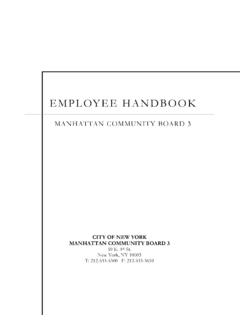Transcription of Compensation in the 1970s - Bureau of Labor Statistics
1 Bureau OF Labor STATISTICSCOMPENSATION AND WORKING CONDITIONSPage 1 Compensation in the 1970sby Albert E. SchwenkBureau of Labor StatisticsThis article was originally printed in the Fall 2001 issue of Compensation and Working Posted: January 30, 2003 Partly reflecting an oil embargo in 1973 and disruptions to the oil supply in 1979, the economy in the 1970s experienced periods of inflation, recession, and high unemployment. The economic conditions led to price controls and new and enhanced programs to combat poverty and unemployment. The decade also saw the United States' continued presence in Vietnam, a conflict that brought substantial political and social unrest to the country.
2 The decade was also marked by a growing importance of women in the workforce, as well as an aging of the workforce. During this period, there were important legislative and legal changes affecting Compensation and workplace , Recession, And High UnemploymentFor many, the 1970s was a decade of pessimism. It opened with a recession in 1970 and the painful ending of the Vietnam War. Memories of the Great Depression made policy makers unwilling to use restrictive monetary and fiscal policy to contain inflation, because it was felt that the associated increase in unemployment would be Instead, wage and price controls were introduced in August An oil embargo, in 1973, brought on by the Organization of the Petroleum Exporting Countries (OPEC), led to rapid inflation and a recession; and there was another round of disruptions to the oil supply in the civilian unemployment rate and the rate of change in consumer prices deteriorated in the second half of the decade.
3 Between 1970-74, the average annual unemployment rate was percent, while the average annual change in the Consumer Price Index (CPI) was percent. From 1974-79, the figures edged up to percent for unemployment and percent for the decade was also marked by a number of large, highly publicized Labor disputes. For example, in 1970, almost 210,000 postal employees walked off their jobsthe first mass work stoppage in the history of the Postal Service. In the same year, four railroad unions conducted a 1-day nationwide railroad strike. In 1971, two longshore strikes closed all major ports on the East, Gulf, and West Coasts; West Coast longshore workers resumed their strike after an emergency dispute injunction temporarily halted the walkout.
4 In 1975, 80,000 employees of Pennsylvania conducted the first legal strike by State workers. In 1977-78, miners conducted one of the longest strikes in the coal industry. The decade ended with a 10-day nationwide strike by 219,400 over-the-road and local truckers in April Component1966197019771986 Total compenation100100100100 Wages and and Bureau OF Labor STATISTICSCOMPENSATION AND WORKING CONDITIONSPage 2 Through the tumult, there was a continued change in the relative importance of benefit costs as a percent of Compensation , rising from about a fifth of total Compensation in 1970 to more than a quarter in 1986.
5 Every measured benefitthe relatively small supplemental pay exceptedincreased as a share of the Compensation the 1970s , there were some important legislative and legal changes affecting Compensation and workplace issues. Among the most important were the employee Retirement Income Security Act of 1974 (ERISA) and the Revenue Act of 1978. ERISA regulated private pensions and imposed financial and accounting controls. ERISA also established the Pension Benefit Guaranty Corporation to ensure that workers would be paid their vested pension benefits, if their pension plans were terminated. The Revenue Act encouraged flexible benefit plans, and created the 401(k) defined contribution retirement savings plan.
6 It also allowed employees to make elective pre-tax contributions to a variety of savings vehicles, such as saving, profit sharing, and employee stock ownership plans. In retrospect, these laws were extremely important, as they contributed to the change in the share of Compensation accounted for by pensions and other retirement important legislation that affected active and retired workers without necessarily affecting Compensation directly included the Occupational Safety and Health Act of 1970, which authorized the Secretary of Labor to establish occupational safety and health standards in the workplace.
7 The Comprehensive Employment Training Act of 1973, which consolidated and decentralized Federal employment programs and provided funds to State and local governments who sponsored employment services; and the 1974 amendment to the Social Security Act, which provides automatic cost-of-living adjustments, based on the Bureau s Consumer Price of wage and price controls showed a need for a comprehensive measure of Labor cost changes that was not affected by factors such as changes in overtime hours or shifts in employment among industries and As a result, the Employment Cost Index (ECI) was born. The ECI was designed to: Be a timely and comprehensive measure covering all elements of employee Compensation (wages, salaries, and benefit costs) and all employees in the civilian economy.
8 Be a fixed-weight index free from the influence of employment shifts among occupations, industries, and establishments with different wage and Compensation levels. Include internally consistent subseries (for example, occupational and industry groups) that describe the forces contributing to aggregate wage and Compensation ECI, first published for the period September-December 1975, initially covered wage and salary changes for the private nonfarm economy. Changes for broad occupational and industrial groups, as well as changes by union status, geographic region, and area size were also presented. Although only a few new ECI series were added in the latter half of the 1970s , work was done to make possible publication of indexes for benefit costs and total Compensation and to include State and local government 1973, the General Accounting Office (GAO) issued a report on the Bureau s white-collar pay surveythe Professional, Administrative, Technical, and Clerical survey (PATC)emphasizing the need to expand the coverage of the survey.
9 In the mid- 1970s , the Bureau took action on GAO recommendations to improve the PATC survey, by expanding occupational coverage from 72 occupational work levels in 1975 to 100 in 1982. During the 1970s , BLS also developed a comprehensive training program, instituted a new quality measurement program, and conducted additional research to review and improve occupational definitions used in the the late 1970s , at the request of the Civil Service Commission (now the Office of Personnel Management), the Bureau began gathering data on employee benefit plan provisions. The program, first called the Level of Benefits survey (LOB) and then the employee Benefits Survey (EBS), was designed to provide information necessary for the Federal pay comparability process established by the Federal Reform Act of 1962 and later by the Federal Pay Comparability Act of 1970.
10 Combining the LOB data with white-collar pay data was designed to help the Office of Personal Management compare Compensation of Federal and private sector Bureau OF Labor STATISTICSCOMPENSATION AND WORKING CONDITIONSPage 3In 1979, a test survey was conducted in conjunction with the Bureau s collection of white-collar salary data that had the same industry and size-of-establishment restrictions. The test collected data for full-time workers on plan provisions and participation for six paid leave items, including sick, holiday, and vacation pay; health, life, and disability insurance; and pension the 1970s , the Bureau continued to enhance its Industry Wage (IWS), Area Wage (AWS), and Service Contract Act (SCA) surveysthe latter to help ESA administer the SCA.














